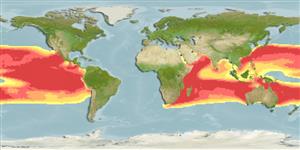Classification / Names
Common names from other countries
Main reference
Size / Weight / Age
Max length : 348 cm FL male/unsexed; (Ref. 40637); common length : 270 cm TL male/unsexed; (Ref. 9308); max. published weight: 100.2 kg (Ref. 40637); max. reported age: 13 years (Ref. 53742)
Environment
Marine; pelagic-oceanic; oceanodromous (Ref. 51243); depth range 0 - 200 m (Ref. 54238), usually 30 - ? m (Ref. 9688)
Climate / Range
Subtropical, preferred 28°C (Ref. 107945); 50°N - 43°S, 16°E - 71°W (Ref. 43)
Distribution
Indo-Pacific: tropical and temperate waters approximately 45°- 50°N and 40°-35°S in the western Pacific, 35°N and 35°S in the eastern Pacific; 45°S in western Indian Ocean and 35°S in eastern Indian Ocean. Entered Mediterranean Sea from Red sea via Suez Canal. Highly migratory species, Annex I of the 1982 Convention on the Law of the Sea (Ref. 26139). Some authors recognize a single worldwide species, Istiophorus platypterus (Shaw & Nodder 1792) but we follow Nakamura 1990 (Ref. 10820) retaining the usage of Istiophorus platypterus for the Indo-Pacific sailfish and Istiophorus albicans for the Atlantic sailfish in recognition of the differences between them.
Countries | FAO areas | Ecosystems | Occurrences | Introductions
Short description
Dorsal
spines
(total): 0;
Dorsal
soft rays
(total): 47-53;
Anal
spines: 2;
Anal
soft rays: 12 - 15. Body elongate and compressed; upper jaw prolonged into a very long beak; two dorsal fins, the first very large and tail; pelvic fins narrow but very long, almost reaching anus, with 1 spine and 2 rays; body covered with small, embedded scales with 1 or 2 blunt points; back dark with about 20 bluish vertical bars; belly pale silver; membrane of first dorsal fin blue black with numerous dark spots (Ref. 55763). A slender billfish with a high, sail-like first dorsal fin (Ref. 26938).
IUCN Red List Status (Ref. 115185)
Threat to humans
Harmless
Human uses
Fisheries: commercial; gamefish: yes
More information
ReferencesAquacultureAquaculture profileStrainsGeneticsAllele frequenciesHeritabilityDiseasesProcessingMass conversion
Tools
Special reports
Download XML
Internet sources
Estimates of some properties based on models
Phylogenetic diversity index
PD50 = 0.7505 many relatives (e.g. carps) 0.5 - 2.0 few relatives (e.g. lungfishes)
Trophic Level
4.5 ±0.3 se; Based on diet studies.
Resilience
Low, minimum population doubling time 4.5 - 14 years (rm=0.11; K=0.4-0.8; tmax=13)
Vulnerability
High to very high vulnerability (68 of 100)
Price category
